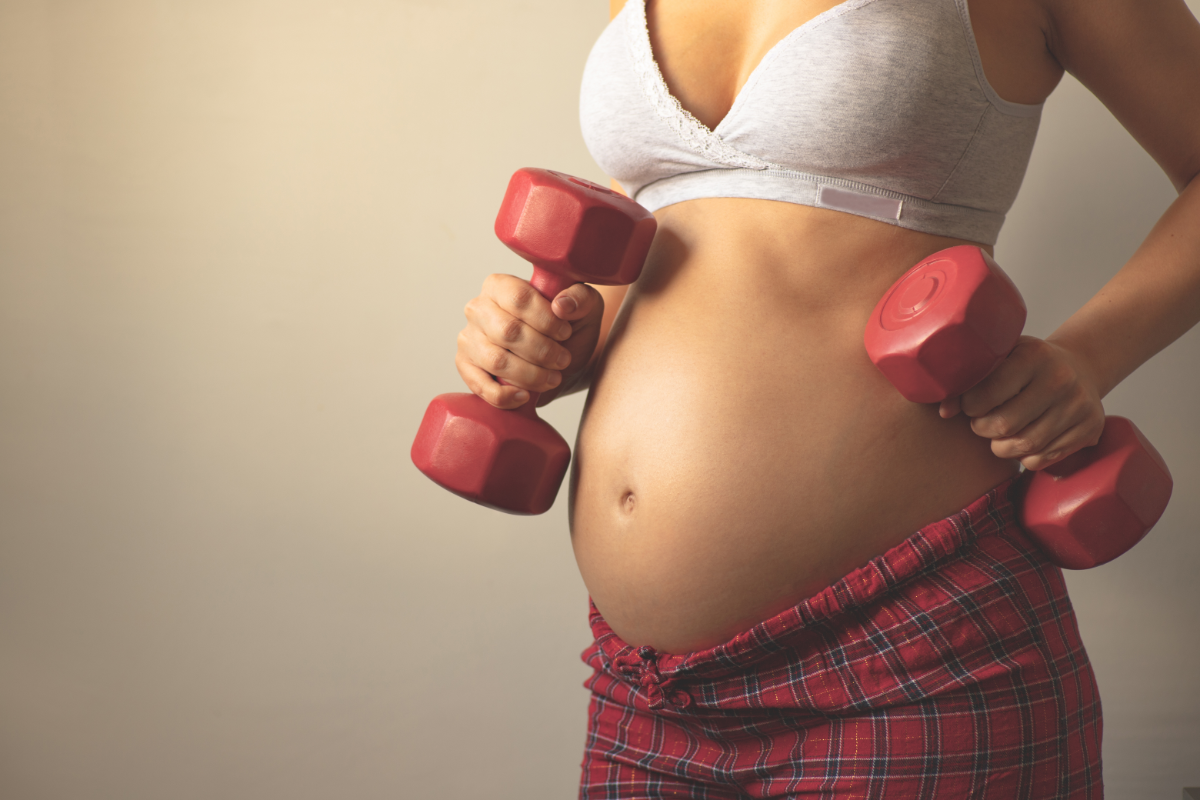All the specialists agree that physical exercise is highly recommended during pregnancy. Indeed, there are many benefits to be gained from sport before childbirth. However, to take full advantage of these benefits, there are a few recommendations to bear in mind. In this article, find out which sports to do during pregnancy and what you need to know before you start.
The benefits of doing sport when you’re pregnant
Sport has many benefits for pregnant women. Physical activity helps to strengthen and maintain the muscles, which are put to the test during pregnancy. Regular exercise also improves blood and lymph circulation, which slows considerably during this period. So you don’t have to worry about heavy legs. Activating your metabolism is also one of the benefits of exercising while pregnant. It makes it easier for you to burn calories and control your weight gain. Physical effort is also your best friend for clearing your mind and relieving stress. So not only will you be zen in the months leading up to the birth, but you’ll also get better quality sleep. Lastly, repeated specific movements will ease your bowel movements, helping you to avoid the problems of constipation that are common among pregnant women.
Physical health
Practising sport during pregnancy offers a number of physical health benefits. Firstly, it contributes to better weight control. Controlled weight gain reduces the risk of complications such as gestational diabetes and hypertension. Secondly, regular exercise strengthens muscles and improves posture, reducing the back pain often associated with pregnancy. It can also help prevent or relieve common discomforts such as cramps and swelling. Moderate physical activity also prepares the body for childbirth. It increases endurance and strength, valuable assets for labour.
Mental health
Mentally, exercise plays an equally crucial role. It releases endorphins, often called happy hormones, which boost mood and combat prenatal depression. Regular physical activity improves sleep quality, something that is often disrupted during pregnancy. It is also an effective way of managing stress and anxiety. By taking part in physical activities, the mother-to-be creates a space to focus on her own well-being, which can boost her confidence ahead of childbirth. In short, sport during pregnancy acts as a powerful emotional regulator, contributing to a healthy mental balance.
Things to know and do before you start
As you will have realised, sport is good for your body, but it’s also good for your mind. That said, before embarking on this adventure, it is obviously advisable to consult your GP. There are contraindications that you need to take into account. Especially if you have any health problems. He’ll be able to tell you what they are during the consultation, but here’s a short list of do’s and don’ts in terms of physical exercise during pregnancy:
- Don’t force yourself and don’t make any sudden movements
- Do stop and rest if you find it difficult or if you’re out of breath
- Do physical activities at the beginning of the day, not at the end, so as not to disturb your sleep
- Opt for gentle, easy activities. Avoid strenuous exercise: horse riding, tennis, skiing, etc
- Stay well hydrated, follow a suitable diet and consume supplements rich in vitamins and trace elements
- Always find out about the products on offer in the “maternity” aisles that can help you before you buy them
- This list is not exhaustive and may vary depending on your state of health. In fact, if you’re suffering from pregnancy-related problems, you can turn to homeopathy.
What sports can I do during pregnancy?
Pregnancy is a time of great change for a woman. It brings many good things, but also its share of challenges and uncertainties. One of the biggest challenges is maintaining a good level of physical fitness while looking after the health of your baby. Fortunately, there are many sporting activities that can be practised safely during pregnancy, offering a way to feel fit and healthy. Let’s explore the different sports you can do during pregnancy to help you stay fit and prepare to welcome your new baby with confidence.
Walking
Walking is the best way to keep fit throughout pregnancy. You don’t need any equipment, so you can do it almost anywhere. That said, it’s important to choose paths that are stable and not steep, to avoid turning your walk into a hike or trek. We recommend walking for around 30 to 60 minutes a day. It tones your muscles and improves blood circulation – a godsend if you suffer from heavy legs! What’s more, walking is a simple and accessible form of exercise that can offer many benefits for pregnant women. Here are some of the benefits of walking during pregnancy:
- Improves blood circulation: Walking helps to stimulate blood circulation, which can reduce the risk of complications during pregnancy.
- Promotes healthy weight gain: Walking can help control weight during pregnancy, which is important for the health of both mother and baby.
- Strengthens muscles: Walking can strengthen leg muscles, which can help prevent back pain and cramps.
- Stimulates endorphins: Walking can improve mood and reduce stress by stimulating the production of endorphins, the “happy neurotransmitters“.
- Prepares the body for childbirth: Walking can help strengthen pelvic muscles and prepare the body for childbirth.
Prenatal yoga
Yoga can be an excellent way for pregnant women to maintain their physical and mental fitness. Indeed, this practice offers a variety of benefits during pregnancy. Firstly, yoga can help to improve blood circulation and prevent cramps, thanks to the gentle, controlled movements that are characteristic of this activity. In addition, yoga can strengthen leg and back muscles, which can help prevent back pain and cramps common during pregnancy.
In addition, yoga can offer relief from stress and anxiety by providing a recreational activity that helps you focus on the present moment. This can help pregnant women relax and focus on their bodies and their developing babies. Finally, yoga can also strengthen breathing and improve posture, which can help prepare the body for childbirth.
Swimming
Swimming and/or aqua aerobics are two physical activities that should be practised during pregnancy. Swimming increases your heart rate and helps you look after your joints at the same time. What’s more, thanks to the multiple movements you need to make, swimming is your best friend when it comes to keeping your figure. And as an added bonus, swimming relaxes your muscles and joints, as the water has a massaging effect on the whole body. In fact, swimming is a popular sporting activity for pregnant women because of its many benefits. Here’s how swimming can help women stay fit and healthy during pregnancy:
- Relieves aches and pains: Swimming helps reduce aches and strains in the body due to the buoyancy offered by water. Swimming movements also help relieve back and leg pain common during pregnancy.
- Promotes healthy circulation: Water acts as a gentle massage for the legs and feet, which can improve circulation and prevent pain and cramp.
- Improves balance and posture: Swimming can help improve balance and posture because of the gentle, controlled movements required for swimming. This can help prevent falls and injuries during pregnancy.
- Makes childbirth easier: Swimming can help prepare the body for childbirth by strengthening pelvic muscles and improving flexibility.
- Reduces stress and anxiety: Swimming can help reduce stress and anxiety by providing an enjoyable recreational activity. Water can also help reduce feelings of anxiety by creating a calm and peaceful environment.
Tips for safe sport
Hydration and nutrition
Good hydration is essential when practising sport, especially during pregnancy. Drinking enough water before, during and after exercise prevents dehydration, which can have harmful consequences for both mother and baby. In addition, a balanced diet, rich in essential nutrients, supports physical activity. It provides the necessary energy and contributes to effective recovery. It is advisable to choose foods rich in protein, fibre and vitamins. Eating small, frequent meals can also help maintain stable energy levels.
Appropriate equipment
The choice of equipment plays a key role in the safety of physical activity during pregnancy. Comfortable, tailored clothing that supports the tummy offers both comfort and protection. Supportive footwear is important to prevent falls and reduce the impact on joints. A suitable sports bra is also essential for adequate support.
Frequency and intensity
When it comes to frequency and intensity, it’s crucial to listen to your body and adjust your activity accordingly. Moderate exercise, without excess, is recommended. Experts generally suggest 30 minutes of moderate activity most days of the week. However, you should adapt the intensity according to how you feel and medical advice. Avoid exercising at a level that causes excessive fatigue or breathlessness. Finally, it is advisable to include rest and recovery periods in your training programme.
What sports should I avoid during pregnancy?
High-impact sports
During pregnancy, it is advisable to avoid high-impact sports. These activities include running, jumping, or any sport where the feet frequently leave the ground. These movements can put excessive pressure on the already strained pelvic floor. They also increase the risk of injury and falls, which can endanger both mother and baby. What’s more, high-impact sports can exacerbate backache and joint pain, which are already common during pregnancy. So it’s best to opt for gentler, low-impact activities.
Risky sports
High-risk sports include those where there is a danger of falling or colliding. These include horse riding, skiing, cycling over rough terrain and combat sports. These activities significantly increase the risk of abdominal trauma, which can be serious for both the pregnant woman and her baby. In addition, pregnancy alters the centre of gravity and can affect balance, making falls more likely. It is therefore advisable to avoid them in favour of safer practices that guarantee the protection of both mother and unborn child.
Source:
https://dumas.ccsd.cnrs.fr/dumas-01566230/document







